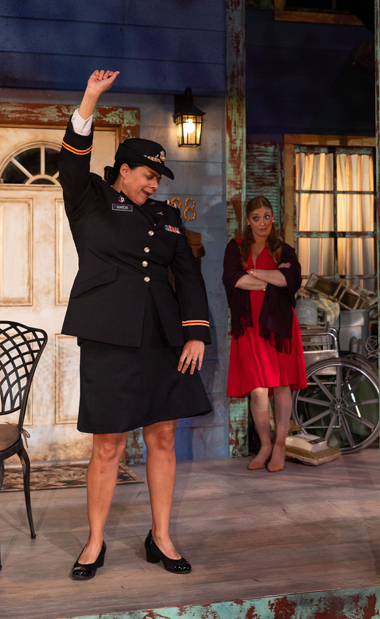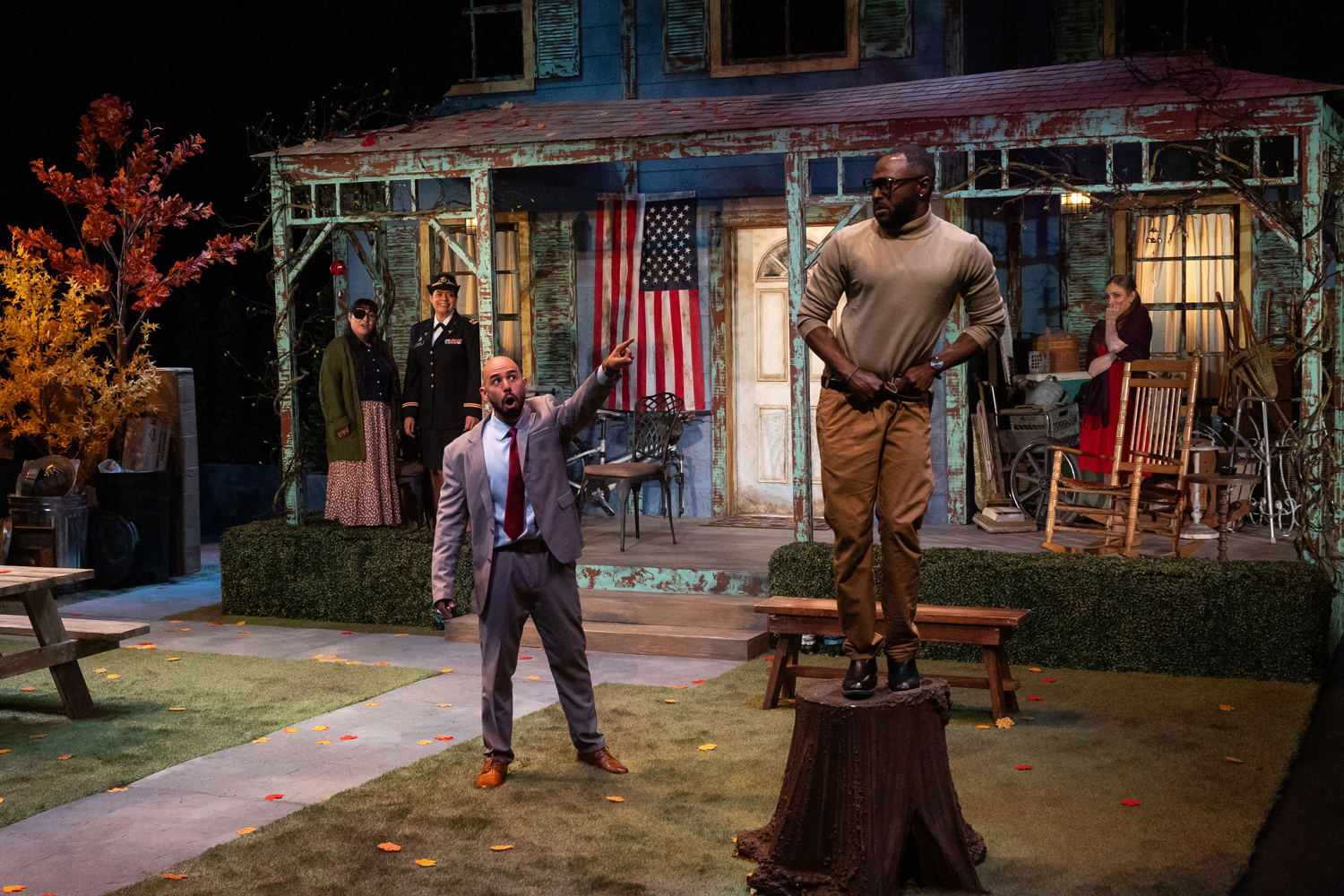
Francisco (Rayner Gabriel) challenges Emilio (Jovon Jacobs) during a scene from Zoetic Stage Company's production of Brendan Jacobs Jenkins powerful play, "The Comeuppance." (Photo by Morgan Sophia Photography/courtesy Adrienne Arsht Center)
I want to say it’s too much for one lifetime…It’s like too much, Columbine, 9/11, the war, the war, the war, then Trump, then COVID, whatever the f—k is going on in the Supreme Court -- From Branden Jacobs-Jenkins' "The Commeuppance."
Raise your hand if you can relate. In a tone of overwhelmed exasperation, a character delivers the above line in Branden Jacobs-Jenkins’ layered, funny, dark, and moving play “The Comeuppance.” In fact, more than one character allows him or herself to act vulnerable in front of their peers – and us—in the complex, thought-provoking piece. It is receiving a powerfully real – and surreal – professional production through Sunday, May 25 by the Zoetic Stage Company in downtown Miami.

Emilio (Jovon Jacobs) ponders something during his and his classmates' pre-high school reunion gathering. (Photo by Morgan Sophia Photography/courtesy Adrienne Arsht Center)
The production runs roughly two hours and 15 minutes without intermission in the Adrienne Arsht Center’s intimate Carnival Studio Theater. Despite no break, the straight-through run helps maintain the production’s dramatic momentum. While it seems overly long at times, the length symbolizes an extended and emotional evening for the characters.
Under Zoetic Stage Founding Artistic Director Stuart Meltzer’s expert direction, a cast of five local and talented actors deftly bring their characters to convincing life. The performers, alternating between subtle yet telling expressions and bigger acting choices, make millennials Francisco, Kristina, Emilio, Ursula, and Caitlin seem relatable, recognizable, and imperfect. In fact, the actors even humanize Death during some sequences, making this omnipresent “character” a sympathetic being -- not just some creepy force out to take people before their time.
The actors are Rayner Gabriel, Amy Lee Gonzalez, Jovon Jacobs, Joline Mujica, and Mallory Newbrough.
Jenkins, a creative and experimental playwright, is a multi-award-winning writer. His piece, “Purpose,” currently running on Broadway, just received the Pulitzer Prize for Drama among other honors. In fact, Jenkins can boast that for two consecutive years, he has had a hit play on the Great White Way.

Chaos ensues during an intense moment between the characters. (Photo by Morgan Sophia Photography/courtesy Adrienne Arsht Center)
Often, Jenkins challenges conventional theatrical forms. He also provokes critical thought and discussion. His work critiques race, class, and other societal inequalities through humor, satire, and dramatic intensity.
Jenkins' his highly-regarded play “Appropriate” received a remarkable production at GableStage in February.
"The Commeupance," however, does not delve into race as much as some of the playwright’s other work.

Ursula (Joline Mujica) and Caitlin (Mallory Newbrough) share a laugh, Photo credit is Morgan Sophia Photography/courtesy Adrienne Arsht Center.
In the play, set near Washington D.C. in 2022, Jenkins blends naturalistic group dialogue with surreal monologues delivered by Death. The characters, millennials who were classmates and graduated from high school in 2002, encounter Death during the play. More specifically, each group member delivers at least one monologue during which Death “possesses” them. The speeches are not random; they often foreshadow key turning points in the characters’ lives or hint at their eventual fate. The characters smoothly slip in and out of realism and metaphysical narration. The result is often a unique rhythm that grabs our attention and keeps it.

Kristina (Amy Lee Gonzalez) lives it up as Caitlin (Mallory Newbrough) looks on. (Photo by Morgan Sophia Photography/courtesy Adrienne Arsht Center)
With its brutal honesty, and complexity, “The Comeuppance” may frustrate you and upset you -- who wants to think about Death?! But the piece should also move audiences, making them laugh, reflect, and appreciate life’s weight and youth’s fleeting nature.
“The Comeuppance” is not plot-driven; it features little to no “action.” And there are no major plot twists or external events. Instead, the drama stems from long-festering tensions over the characters’ high school years, psychological revelations, and subtle power shifts within the group. The play is a more intense, disturbing, and modern-day version of the classic 1983 film “The Big Chill.”
As intricate as the play may seem, it all unfolds over one evening. The group gathers outside Ursula’s run-down home, rendered with authentic detail by scenic designer Michael McClain, for a pre-reunion gathering. One quibble: The home’s owner claims that as a “COVID project” she renovated the place. If that is true, she did not pay much attention to renovating the exterior. It looks dilapidated.
During high school, they called themselves the Multi-Ethnic Reject Group (MERGE). They bonded over their perceived outsider status from mainstream social circles at their high school.
Now, 20 years after their graduation, they reunite. Over pot and alcohol, the characters reminisce, share regrets, fight, and express their anxieties. The characters are like simmering volcanoes weighed down with worries. However, despite the weight they carry, these folks seem ready to erupt following the slightest provocation. Their pot and alcohol, along with their complex feelings, fuel their explosions.
Meltzer and his team ensure the transitions between quiet and explosive moments happen seamlessly, practically unnoticeably. The characters seem trapped on stage, as though they cannot escape their past or present, thanks to the audience seating configuration that Meltzer has chosen. Audience members surround the stage on three sides and sit quite close to the actors, resulting in powerful performances. Jacobs brings impressive nervous energy to Emilio, capturing the character’s desperation with a raw, almost feral edge. Gabriel matches Jacobs’ intensity with a larger-than-life presence of his own.
The female performers portray characters who can be emotional as well, but they seem a bit more subdued than their male counterparts.
Mostly, this production differentiates realistic scenes from surrealistic ones through upsetting sounds and lighting effects. Before each character “becomes” Death, the lights flicker and those sounds reverberate. The mood-enhancing lighting, by designer Leonardo Urbina, mostly remains dim or assumes a red hue as Death addresses us. When the actors speak as Death, it sounds as though an echo-like and strange voice accompanies them, giving their voices an otherworldly, sometimes chilling quality. At times, an actor may move into the audience seating area as Death and appear to address individual audience members. This directorial choice reinforces the notion that Death is universal; each of us will die at some point.

Francisco (Rayner Gabriel) and Emilio (Jovon Jacobs) interact. (Photo by Morgan Sophia Photography/courtesy Adrienne Arsht Center)
The cast works well as an ensemble; they listen to each other, and are believable as a once-close group trying, and sometimes failing, to recapture the fun of their high school years.
Individually, each crafts memorable portrayals that capture their character’s complex and varied emotions. It is hard to describe individual performances because each is so multi-dimensional. Each character arc unfolds believably and fluidly.
Admittedly, “The Comeuppance” can make audiences uncomfortable. And if you do not like to wrestle with ambiguity, the play may trouble you. But the piece also compels us to look inward — at our own imperfections, regrets, and relationships. In uncertain times, "The Comeuppance" reminds us that connection — fragile, necessary, human — may be the only thing that truly anchors us.
IF YOU GO
- WHAT: Zoetic Stage’s professional production of “The Comeuppance,” by Brendan Jacobs-Jenkins.
- WHEN: Performances are at 7:30 p.m. Wednesday-Saturday, and 2:30 Sunday. Through Sunday, May 25.
- WHERE: Adrienne Arsht Center’s Carnival Studio Theater, 1300 Biscayne Blvd. in Miami.
- TICKETS: $66-$72. Go to www.arshtcenter.org.




